Art Fairs
Inexhaustible Collector Frédéric de Goldschmidt Takes Us on a Tour of Brussels’s Ultra-Cool Emerging Art Scene
We shadow the Belgian collector around Art Brussels.
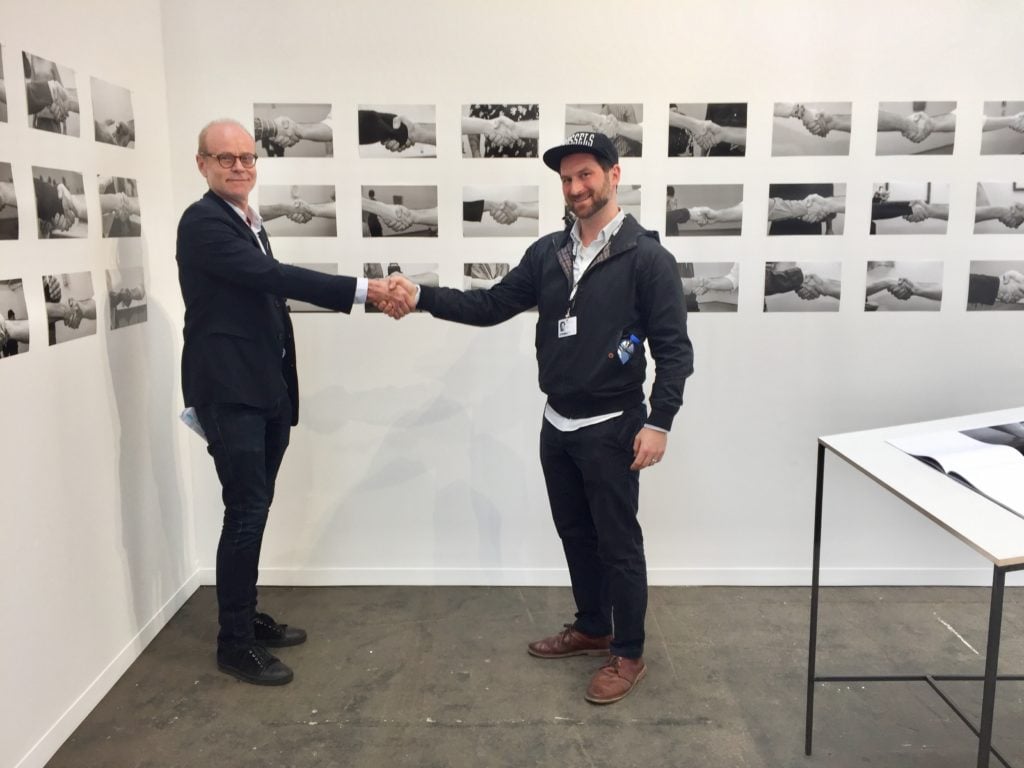
We shadow the Belgian collector around Art Brussels.

Naomi Rea

The collector Frédéric de Goldschmidt goes radio silent the night before we are due to meet at Art Brussels, his “local” art fair. It’s gallery night in the Belgian capital, and after a hectic evening touring galleries, he is hanging out with the cool kids at an art party at Jane’s Bar in the Ixelles district.
Thanks to a tip-off, and a direct message via Instagram, we arrange to rendezvous the following morning ahead of the VIP preview of the fair. I make my way at the agreed-upon hour to a beautiful building in Brussels’s old port district and wait for him to come downstairs.
Dressed in jeans, a jacket, and de rigueur sneakers, de Goldschmidt arrives accompanied by his friend, the Brussels-based, US artist Will Kerr. He is presenting an experimental work at the fair on the booth of one of the cooler galleries, Counter Space, which is exhibiting in the fair’s new “invited” section. Kerr jokingly compares the new section, which offers cheaper booths to galleries subverting the traditional model, to sitting at the “kid’s table” at a dinner party.
De Goldschmidt might be based in Brussels but he is, in fact, French; you can tell because he introduces himself with two cheek kisses, as opposed to the single peck favored by the Belgians. We head to the fair, which is held in Tour & Taxis, an early 20th-century, glass-and-iron former shipping and customs hub. Along the way we stop for pastries. “Before an art fair, it’s important to eat a good breakfast,” de Goldschmidt says. “I prefer to look at art than to eat lunch.” He is not kidding. We’re about to spend eight hours immersed in the fair—and then we only cover half of the booths, with the morning spent mainly visiting smaller galleries.
He explains that he likes to find works in the €10,000 range, “but I don’t stop myself from buying more expensive works.” He prefers to own more works than just a few expensive pieces. Although he admits that this might not be a smart financial decision—the more expensive works are more likely to hold their value—he says “it’s more fun to discover young artists and take a chance on them.”
The collector splits his time between Brussels and Paris, where he has a day job as a film producer at Madeleine Films, a company started by his late father, Gilbert de Goldschmidt. His mother was France Roche, the late French journalist and film critic.
He prefers to play down his illustrious ancestry but de Goldschmidt is a part of the Frankfurt branch of the Rothschild banking dynasty. His father, wanting to make a name of his own in the film industry, dropped the “Rothschild” from the family name. De Goldschmidt, too, prefers not to have the association, as “it only causes to make people think you are rich, and increase the price of whatever you want to acquire.” Un-stuffy and friendly, you would never guess.
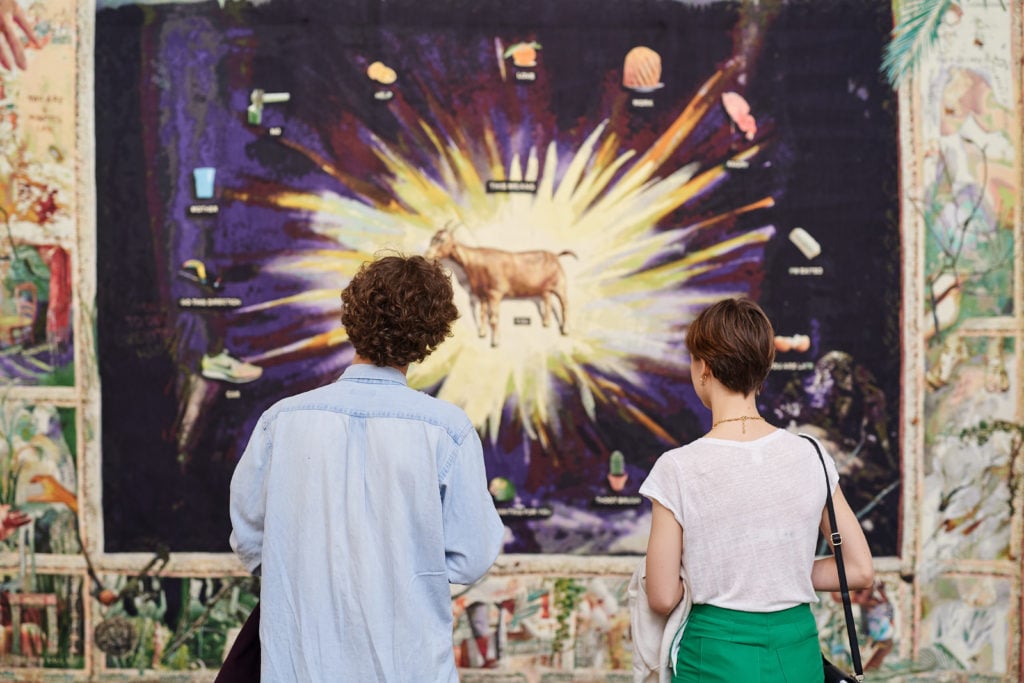
Fairgoers look at a work by Laure Prouvost at Nathalie Obadia in Art Brussels. Photo by David Plas.
The collector was engaged in art from a young age, but it was only in 2007 that he made his first thought out acquisition, a work by the French artist Benjamin Sabatier. The following year he began collecting seriously, and he has been intensely involved in the activity in the 11 years since. He was inspired to collect by his paternal grandmother, who collected Impressionist art. His father also collected art for a spell in the 1970s.
De Goldschmidt’s first key acquisitions were works by the ZERO group artists, such as Heinz Mack, Otto Piene, and Jan Schoonhoven. Nowadays there is no single defining thread in his 1,000-strong collection. He does not discriminate by age, nationality, or medium, but he is attracted to work made with unconventional materials, and with an interesting conceptual depth. “I like to be drawn in by an instinctive attraction to a work before I get to know the conceptual element behind it,” he explains. He also says that his collection is more “extensive” than “intensive,” preferring to make interesting connections between different artists rather than collecting a single name in depth.
As we arrive at the 37th edition of Art Brussels, we make a beeline for a map. There are 157 galleries to see this year, and de Goldschmidt plans on taking everything in. He explains that he is leading a tour of the fair on Sunday, and he wants to research which booths he’ll highlight. So, today is a reconnaissance mission of sorts. He explains that we will be tackling the fair with a combination of “free choice” and strategy; he wants to allow himself to be drawn in by attractive artwork, but also to ensure he doesn’t miss anything.
He is most interested in the fair’s “discovery” section, where the emerging artists and galleries can be found, so we hit that first. We spend time at the London-based Cøpperfield gallery’s booth, where he chats to the artist Darren Harvey-Regan, whose work is already in his collection, about an iconoclastic sourdough bread sculpture fore-fronting the figure of Joseph. He also seems interested in a bronze cast of an ear of corn by Alastair Mackie, based on a rural tradition of spirit-catching to ensure a good harvest. “This would make sense in my collection,” de Goldschmidt says.
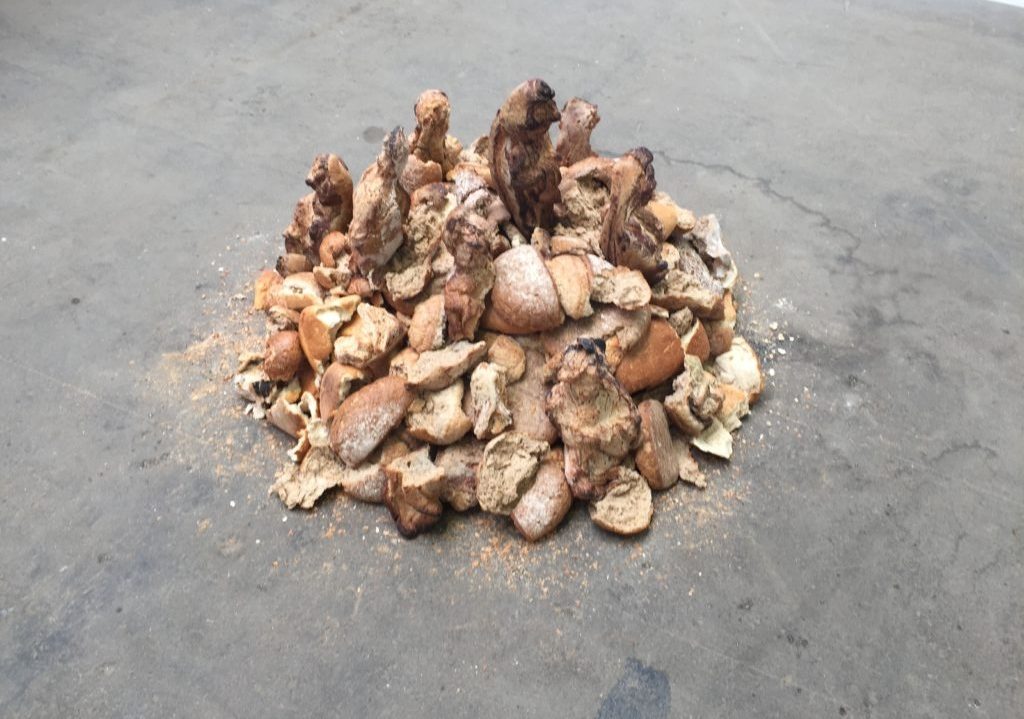
Darren Harvey-Regan’s bread sculpture at Cøpperfield. Photo by Naomi Rea.
As we weave in and out of the booths, dealers happily share the prices of works at de Goldschmidt’s request. (No need to squeeze blood from a stone.) We are hailed by all sorts of art world movers and shakers along the way. Among the many are Bernard Blistène, the director of Paris’s Centre Pompidou, the Delfina Foundation’s Aaron Cezar, and fellow Brussels-based collector Alain Servais. (He is eyeing a work about the food delivery company Deliveroo by artist duo Sander Breure & Witte van Hulzen—which he ends up purchasing—at Amsterdam gallery tegenboschvanvreden. The Dutch gallery won the fair’s “discovery” prize alongside Berlin-based gallery NOME.)
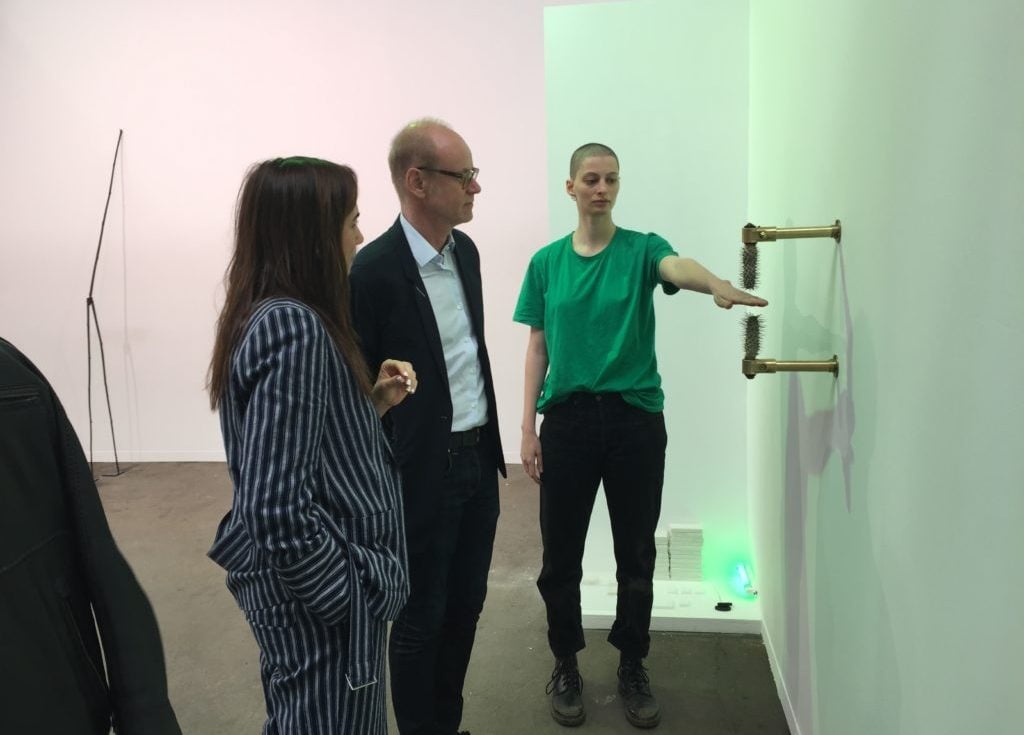
Frédéric de Goldschmidt and gallerist Catinca Tabacaru observe a performer activating Rachel Monosov’s The Space in Between (2019). Photo by Naomi Rea.
As we circulate, de Goldschmidt periodically dips into his breast pocket to hand out invitations to the exhibition “Encounter,” which he is hosting at his space on Rue de Barchon. Usually by-appointment-only, he has opened it up specially so that fair goers can visit the exhibition he has co-curated with its subject, the young Dutch-Japanese-German artist Maria Kley.
When we bump into Olivier Gevart, founder of the Brussels nonprofit space Été 78 that is currently exhibiting a work from de Goldschmidt’s collection, the conversation turns to lending. He is a generous lender, who has never refused a loan, despite sometimes being disappointed when a work he has entrusted is returned damaged. “There are two main responsibilities of a collector,” he says. “The first is to contribute to the market by buying, and the second is to contribute to the recognition of the artists by letting people know and see the works you withdrew from the public eye.”
After two and a half hours visiting the discovery section’s 38 galleries, we break for a perfunctory lunch. De Goldschmidt chooses a poké bowl, water, and an all-natural energy drink from one of the fair’s cafés. We chat about the morning, but nothing has induced him so far to buy or reserve a work.
We are joined by Hugues Albes-Nicoux, founder of a nomadic gallery Un-Spaced, where de Goldschmidt had made his most recent acquisition at Art Paris. The gallerist, who has known de Goldschmidt for seven years, says he has been supportive of galleries that are subverting the traditional model.
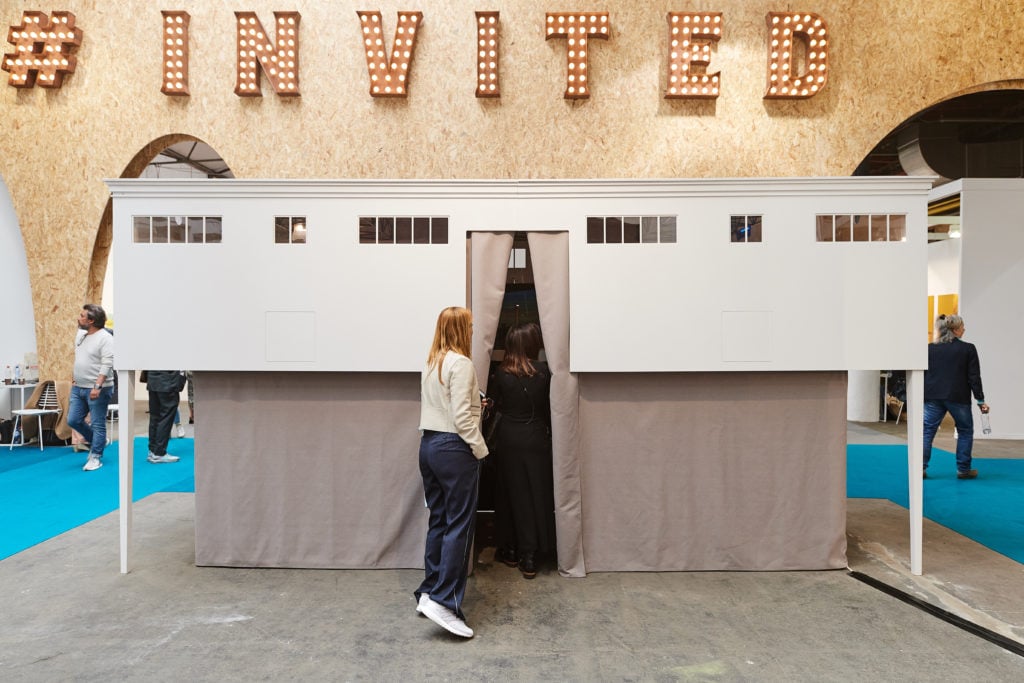
Art Brussels 2019. Photo by David Plas.
Fittingly, then, we head for the fair’s new “invited” section, where subsidized booths have been given over to nine emerging spaces that are doing just that. The collector was involved with the fair’s management in selecting some of the exhibitors, which include a gallery founded by Simon Delobel. This week, at least, the space is called “Paid by the artist;” the gallerist creates a new gallery identity for every exhibition (social media handles and all) as a way to escape the “dictatorship” of the market. A “cash flow” problem at the time of the fair meant the artist, Yannick Ganseman, paid the €4,000 for the booth. (Luckily they sold enough so he could make a small profit.)
Also in the section is the Zurich-based Counter Space, where we head over to see Will Kerr’s work. On the stand there is a delicate porcelain bookshelf by Sebastian Utzni that catches the collector’s interest. We move closer to read the titles of the volumes, which include the complete works of Shakespeare and classic philosophical texts, but we both take an automatic step backwards when the gallerist informs us that the innocent-looking white shelf is actually based on one belonging to Adolf Hitler. Afterwards we notice the military literature and racist texts represented in Die Bibliothek A.H. (2014) .
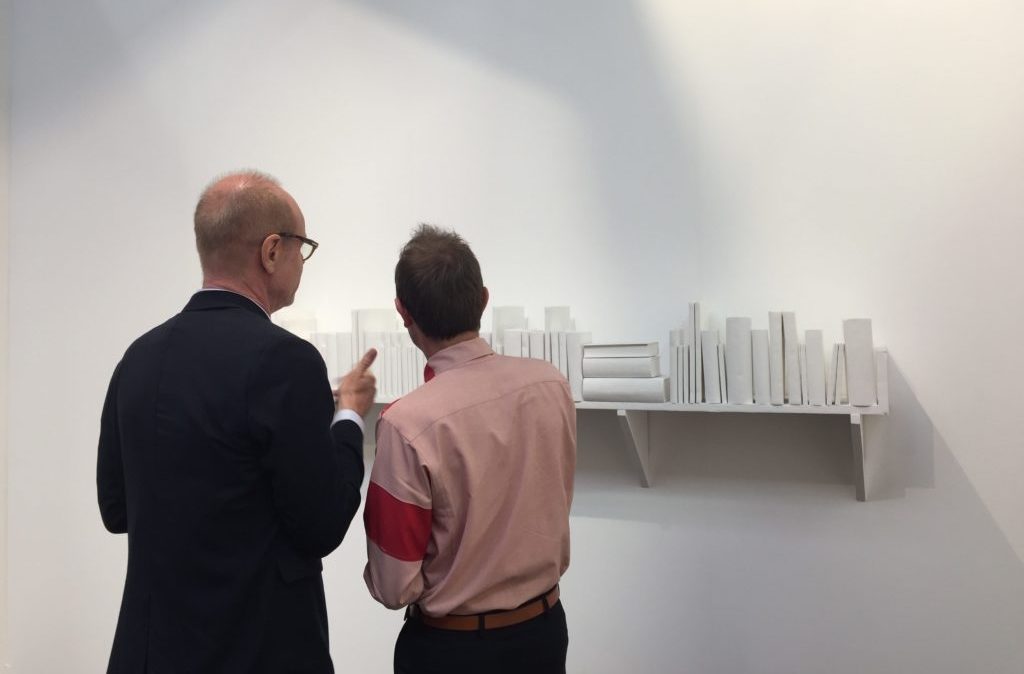
Frédéric de Goldschmidt and artist Sebastian Utzni discuss his work, Die Bibliothek A.H. (2014). Photo by Naomi Rea.
The deceptively innocent-looking work by the young German artist is the first piece de Goldschmidt buys at the fair. (I’m not privy to the final deal as it happens over the weekend but the initial price quoted by the dealer was in the €16,000 range.)
The gallery also represents the Swiss artist Anne Rochat, who staged a memorable performance when she created an ice sculpture by imprinting her naked body onto a block of ice for a full hour. Rochat’s performance drew in a number of fans, which is not to mention Instagram’s algorithm, which made short work of the performance when it swiftly deleted de Goldschmidt’s Insta story of the moment for violating its notorious “community guidelines.”
For the remainder of the afternoon, we take a slightly different approach, a combination of whatever catches his eye and the necessary salutations to familiar faces. We bump into the Belgian artist Wim Delvoye outside the booth of Harlan Levy Projects (which is showing a cool installation by the Belgian artist Emmanuel Van der Auwera, which the gallery managed to find a buyer for in the first hours of the fair). At Mexico City gallery Proyectos Monclova, we meet Slovenian artist Ištvan Išt Huzjan, the subject of a solo presentation of photographs of the artist shaking hands with the visitors to one of his openings, from whom de Goldschmidt has also bought work in the past.
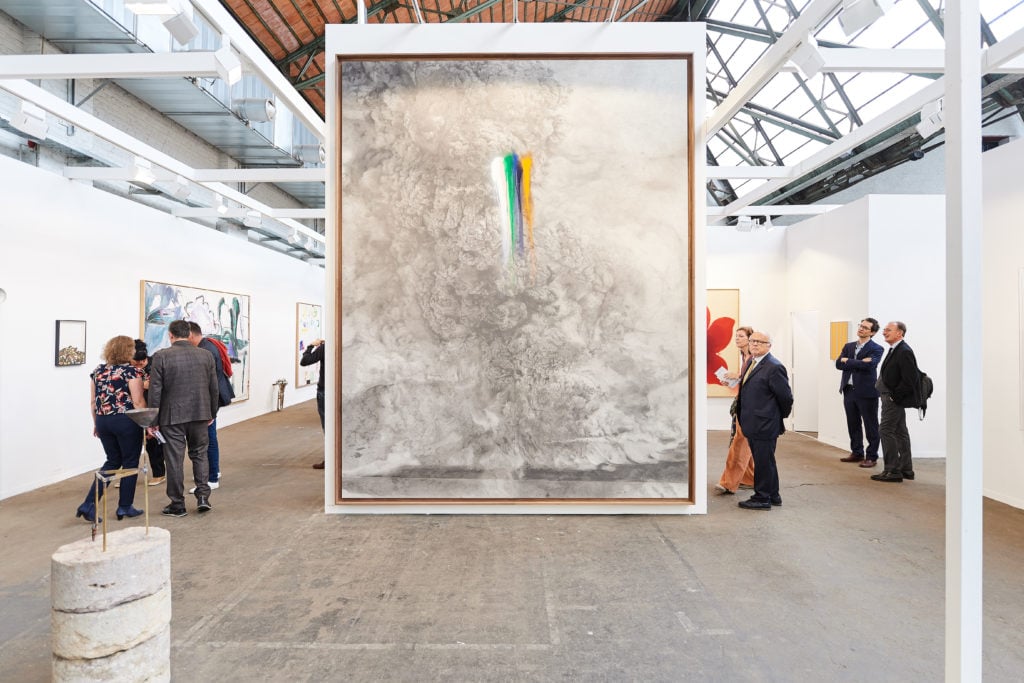
Meessen De Clercq’s booth at Art Brussels 2019. Photo by David Plas.
Next, we head to South African gallery SMAC, which had brought over some works de Goldschmidt acquired earlier in the year at Cape Town Art Fair. He ends up picking up an additional work by the young artist Pierre Vermeulen, the financial details of which are, again, cinched outside of the presence of this arts journalist, although I can tell you the initially quoted price was €6,000. Born in 1992, Vermeulen has work in major collections including the Zeitz Museum of Contemporary Art Africa.
We also pay visits to Brussels gallery dépendance, which was showing work by Jos de Gruyter and Harald Thys, who are representing Belgium at this year’s Venice Biennale. Next stop is Xavier Hufkens, which sold out its booth after winning the €10,000 solo prize for the second year running for its presentation of work by the American abstract painter Lesley Vance.
Some eight hours into our day, we’ve seen a little under half of the fair, which de Goldschmidt assures me is “pretty normal for the first day.” I am run off of my feet, but the collector’s evening is just getting started, and he heads out to the collector’s dinner at the Musée des Beaux Arts.
Next up on the art world calendar is, of course, the Venice Biennale, after which the collector plans to head to ARCO Lisboa if he can swing it as well as the Cannes Film Festival. Later comes Art Basel, and then either Marseille or Copenhagen, and in September and October he is considering ArtRio or Bogotá’s ARTBO, Frieze London (if he can make it), and Paris’s FIAC (certainly). November brings Artissima, which the collector will most likely attend as it’s one of his favorite fairs, and going against the grain of the art world as is his habit, he will most likely skip out on Miami.
The itinerary sounds exhausting but it’s par for the course for de Goldschmidt, whose commitment to contemporary art, and the young artists he champions, means he stands out (ever so discreetly) from the crowd.